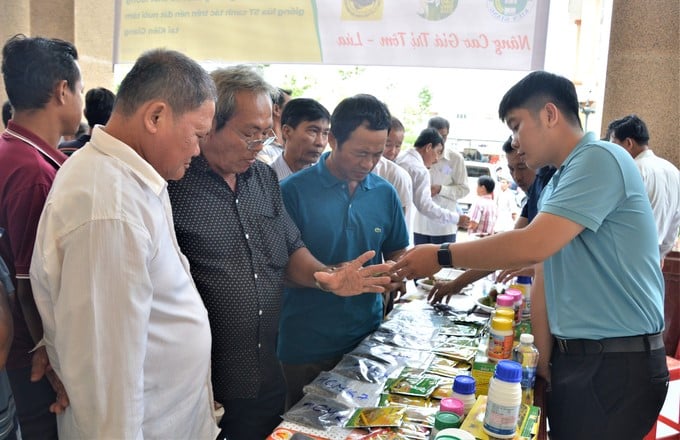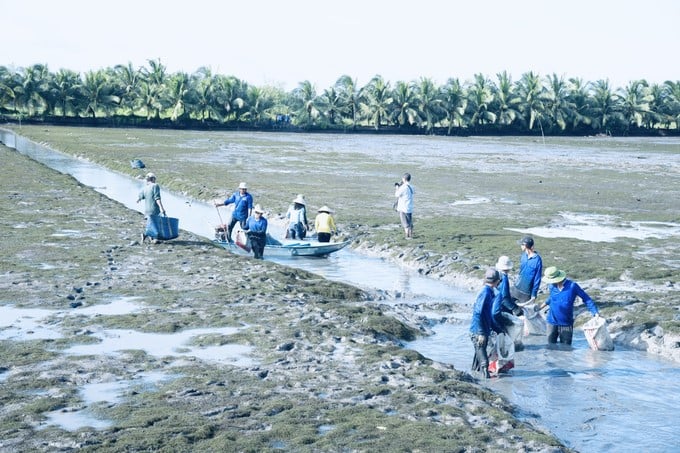May 22, 2025 | 11:37 GMT +7
May 22, 2025 | 11:37 GMT +7
Hotline: 0913.378.918
May 22, 2025 | 11:37 GMT +7
Hotline: 0913.378.918

Delegates attending the workshop visited agricultural material booths. Photo: Trung Chanh.
The rice-shrimp farming system in the Mekong Delta has been confirmed to be sustainable and adaptable to climate change, bringing higher economic efficiency to farmers than monoculture production. However, if not maintained scientifically and strictly, this farming system will be at risk of breaking down.
On July 2, Kien Giang Agricultural Extension Center, in collaboration with Binh Dien Fertilizer JSC and Ho Quang Tri Company with the Ong Cua Rice Brand, organized a workshop on "Improving the rice-shrimp value". The workshop aims to discuss solutions to increase the productivity and quality of ST rice varieties cultivated on shrimp farming land in Kien Giang. The workshop was held in An Bien and An Minh districts (Kien Giang), with the participation of local authorities, agricultural cooperatives, rice-shrimp farmers, and businesses in the rice-shrimp value chain.
Dr. Le Van Dung, Deputy Director of the Kien Giang Agricultural Extension Center, said that Kien Giang province is both affected by floods in the flood season from the Mekong River and intruded by salt water from the sea. Previously, when the province mainly produced under a monoculture of rice or rice-freshwater fish model, saltwater intrusion was always a big challenge for production. However, since 2000, when converting to the rice-shrimp model, salt water has become the advantage to developing brackish water aquaculture and rotating crops in rice fields, bringing higher economic value to farmers.
According to Mr. Dung, in 2010, Kien Giang had approximately 60,000 ha produced under the rice-shrimp model, but now it has increased to 102,400 ha, accounting for nearly 50% of the farming area under this model in the Mekong Delta coastal provinces. After more than 20 years of development, farmers have come up with many creative ways to turn the rice-shrimp model from one-tree, one-animal (growing rice and raising giant tiger prawns) into multi-tree, multi-animal. The rice-shrimp model has now become a rice-shrimp farming system.

Thanks to the shrimp-rice model, high-quality rice meeting strict standards, especially organic rice for export, was produced. Photo: Trung Chanh.
However, rice-shrimp production in Kien Giang is still not sustainable when every year farmers do not refill approximately 40,000 ha with the rice crop. Year-round aquaculture will disrupt the farming system, losing the model’s superiority and sustainability. Therefore, it is necessary to have solutions to help farmers grow back the rice crop, improve the environment, and raise shrimp effectively.
Carrying out agricultural restructuring, Kien Giang province continues to plan and convert an additional 20,000 ha of coastal rice land south of Highway 80 from Hon Dat to Kien Luong in order to expand the farming area according to the rice-shrimp farming system, helping to improve rural income.
According to forecasts, the El Nino phenomenon will return from around June this year and last until the dry season of 2023–2024. Drought and salinity will increase. This is a big challenge for rice production under the rice-shrimp model due to the risk of a fresh water shortage at the end of the crop. Therefore, it is necessary to arrange a reasonable crop, sow seeds earlier than every year, and use rice varieties with salt tolerance to limit possible damage.

The shrimp-rice model has confirmed its superiority and sustainability, but the fact that farmers quit the rice crop in the model for year-round aquaculture will increase the risk of disrupting this farming system. Photo: TL.
Mr. Le Van Khanh, Head of the An Minh Department of Agriculture and Rural Development, said up to now, the district's model of rice-shrimp production has been stable, providing a good source of income. Currently, the whole district has an aquaculture area of more than 47,000 ha, of which 39,000 ha were produced under the rice-shrimp model and 25,000 ha of the farming area were refilled with the rice crop.
In recent years, effective rice production has helped the rice-shrimp model become more and more effective and sustainable. In aquaculture, the farming method has been gradually upgraded to an improved shrimp-rice model, combined with raising giant river prawns or mud crabs. Regarding rice production, the 2022–2023 crop alone has been planted and harvested with an area of approximately 25,580 ha, an average yield of 5 tons/ha, and an output of 130,370 tons. Of which ST varieties account for 30%, the rest are seasonal rice varieties and some other high-yielding rice varieties.
Especially for the implementation of the rice-shrimp value chain, many businesses have signed agreements with agricultural cooperatives in the district to invest in organically certified rice production with an area of approximately 1,000 ha and link consumption of rice produced on shrimp farming land with an area of more than 2,000 ha. Cooperatives in the area have also signed rice consumption contracts with enterprises such as Dai Duong Xanh Company, Ho Quang Tri Company, and Tan Long Group with rice varieties ST5, ST25, and ST24, bringing good profits for farmers.

After each shrimp crop, the field environment will create favorable conditions for the growth of rice. Photo: TL.
Sharing at the workshop, Dr. Nguyen Bao Ve (Can Tho University) affirmed that in the rice-shrimp farming system, rice plays a very important role in cleaning the environment and balancing the field ecosystem. In the dry season, we have to bring salt water into the field to create a brackish water environment for shrimp farming. When it rains, the salt has to be driven away to sweeten the environment for rice growing. For shrimp, only brackish water is needed, while rice, in addition to fresh water, needs a soil environment that is not contaminated with salt, alum, etc.
Therefore, the stage of soil desalination is very important to be able to replant the rice crop effectively. During the cultivation process, do not let the soil dry out, which will lead to salt water seeping deep into the ground. It is necessary to plow the topsoil to remove the saline alum and make trenches, creating conditions for the saline alum to drain away. At the same time, it is necessary to fertilize with the addition of Calcium and Bio to remove soil salinity.
Technician Ho Quang Cua, the "father" of ST rice varieties, stated the sad fact: Currently, the situation of counterfeiting ST rice varieties is becoming popular. For example, in An Bien district (Kien Giang), in the recent rice-shrimp crop, this situation increased to 60–70%.

ST rice associated with the rice-shrimp production model is considered an excellent specialty, but it is also facing challenges because the problem of poor-quality ST varieties is becoming difficult to control.
The lack of ST rice varieties for production is due to an increase in production area, along with the "piracy" situation occurring everywhere, from the US, Australia, and even Vietnam. The more favored ST rice varieties are, the more counterfeiting occurs; not only are the rice seeds packaged in white bags, but also the packaging is imitated, and farmers are deceived and damaged by poor-quality rice varieties.
The rice-shrimp farming system is a very ideal environment for organic rice production as it is less polluted by chemicals. Thanks to the rice-shrimp rotation, the isolation and crop break times are very long, cutting off the source of disease transmission from the previous crop to the next crop.
After the shrimp crop, the residual organic matter in the soil is a source of nutrients to help rice grow, reducing fertilizer costs. On the contrary, rice will clean the environment for shrimp farming, and the decomposed straw will create an environment for many species of organisms to grow, creating food for extensive shrimp farming.
"In the coming time, Kien Giang province will focus on reorganizing production, investing in developing shrimp farming in the direction of organic, ecological shrimp, and investing in infrastructure to expand the rice-shrimp farming area," said Dr. Le Van Dung, Deputy Director of the Kien Giang Agricultural Extension Center.
Translated by Huyen Vu Thu
![Reducing emissions from rice fields: [2] Farmers’ commitment to the soil](https://t.ex-cdn.com/nongnghiepmoitruong.vn/608w/files/news/2025/05/05/dsc08881jpg-nongnghiep-140632.jpg)
(VAN) Clean rice cultivation model in Thuong Tan commune, Bac Tan Uyen district, is assisting local residents in achieving sustainable agriculture by substantially reducing costs, increasing productivity, and protecting the environment.

(VAN) At the conference to disseminate Resolution No. 68, AgriS introduced its digital agricultural ecosystem and reaffirmed its commitment to accompanying the Government in promoting private sector development and sustainable agriculture.

(VAN) 'Blue Ocean - Blue Foods' initiative is designed to restore marine ecosystems and establish sustainable livelihoods for local communities by cultivating a minimum of 1,000 hectares of cottonii seaweed in the first three years.
/2025/05/21/4642-3-112707_603.jpg)
(VAN) The V-SCOPE project has made direct contributions to three out of six pillars of the Comprehensive Strategic Partnership between Vietnam and Australia.

(VAN) Facing the threat of rabies spreading to the community, Gia Lai province urgently carries out measures to vaccinate dogs and cats on a large scale.

(VAN) Disease-free livestock farming not only protects livestock herds but also stabilizes production and livelihoods for many farmers in Tuyen Quang.

(VAN) Japan's grant aid project contributes to capacity building, promoting organic agricultural production, and fostering sustainable community development in Dong Thap province.